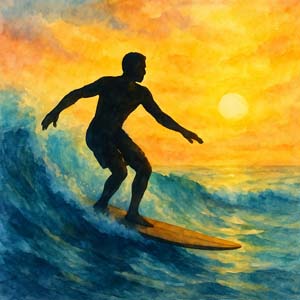— Bob Krauss
 To know Duke Kahanamoku (1890-1968) is to glimpse the living heart of Hawaiʻi. Bold as the waves, gentle as the breeze. Born on O‘ahu, Duke Paoa Kahinu Makoe Hulikohola Kahanamoku embodied aloha in motion. More than a surfer or Olympic swimmer, he moved through the world with grace, humility, and joy. He didn’t just ride waves...He lifted people with him.
To know Duke Kahanamoku (1890-1968) is to glimpse the living heart of Hawaiʻi. Bold as the waves, gentle as the breeze. Born on O‘ahu, Duke Paoa Kahinu Makoe Hulikohola Kahanamoku embodied aloha in motion. More than a surfer or Olympic swimmer, he moved through the world with grace, humility, and joy. He didn’t just ride waves...He lifted people with him.
The native Hawaiian legend was a gold medalist in the 100-meter freestyle at the 1912 and 1920 Olympic Games, introducing the flutter kick and Hawaiian crawl to the world. He is still considered one of the greatest swimmers of all time.
On this day in 1925, Duke became a national hero when he used his surfboard to rescue eight men after their 40-foot fishing boat capsized in rough surf off Newport Beach, California—a feat of courage and calm that defined his life.
Private and humble, he spoke Hawaiian as often as he could and shared his passion for He‘e Nalu—surfing—with the world. In 1915, he introduced the sport to Australia, later carrying his board to America’s Mainland and beyond. He appeared in over 30 Hollywood films, always representing his islands with quiet dignity and warmth.
“Aloha,” Duke said, “is the key word to the universal spirit of real hospitality, which makes Hawai‘i renowned as the world’s center of understanding and fellowship.”
Reverend Abraham Akaka, Duke’s friend, once described him as “the ali‘i nobility in the highest and truest sense—concern for others, humility in victory, courage in adversity, good sportsmanship in defeat. He had a quality of life we are all challenged and inspired to emulate.”
The Duke continues to welcome visitors to Waikīkī. In 1990, a 17½-foot bronze statue of Kahanamoku, arms outstretched in greeting, was dedicated at Kuhio Beach—a timeless reminder of his open-hearted aloha.
“Of all the industrialists, political leaders, and others who have gained fame in Hawai‘i, no one looms greater than Duke Kahanamoku,” said surfer and business leader Fred Hemmings Jr.
 Ride each wave with gratitude. Let your heart stay buoyant and free. 🏄♂️✨
Ride each wave with gratitude. Let your heart stay buoyant and free. 🏄♂️✨
